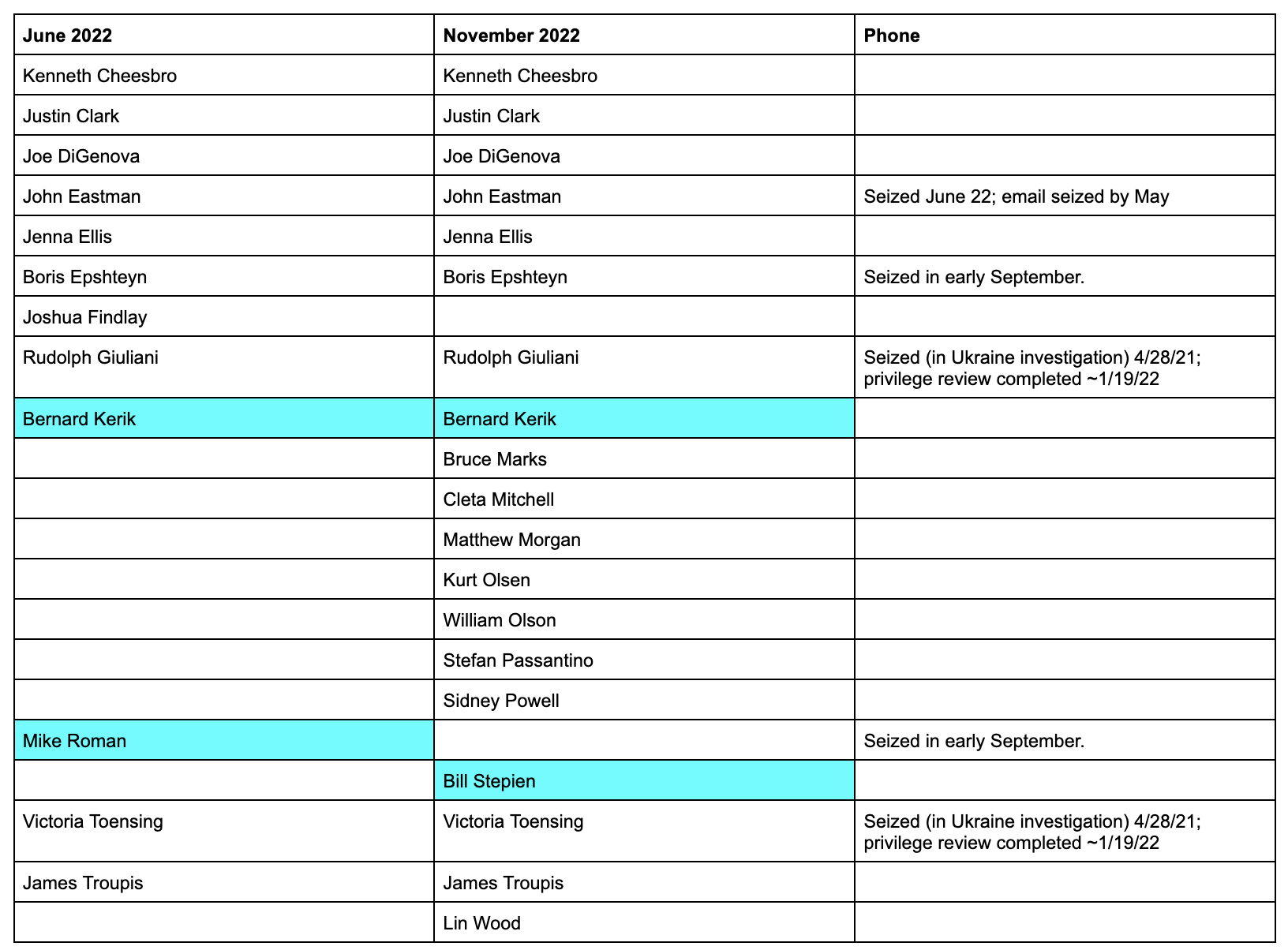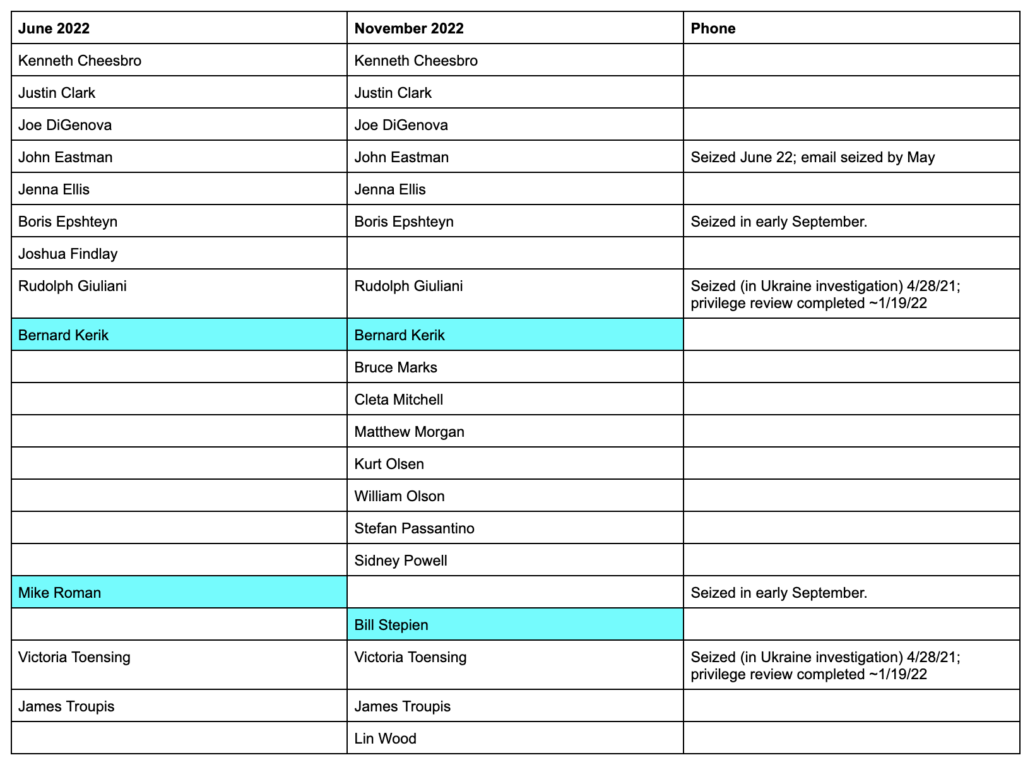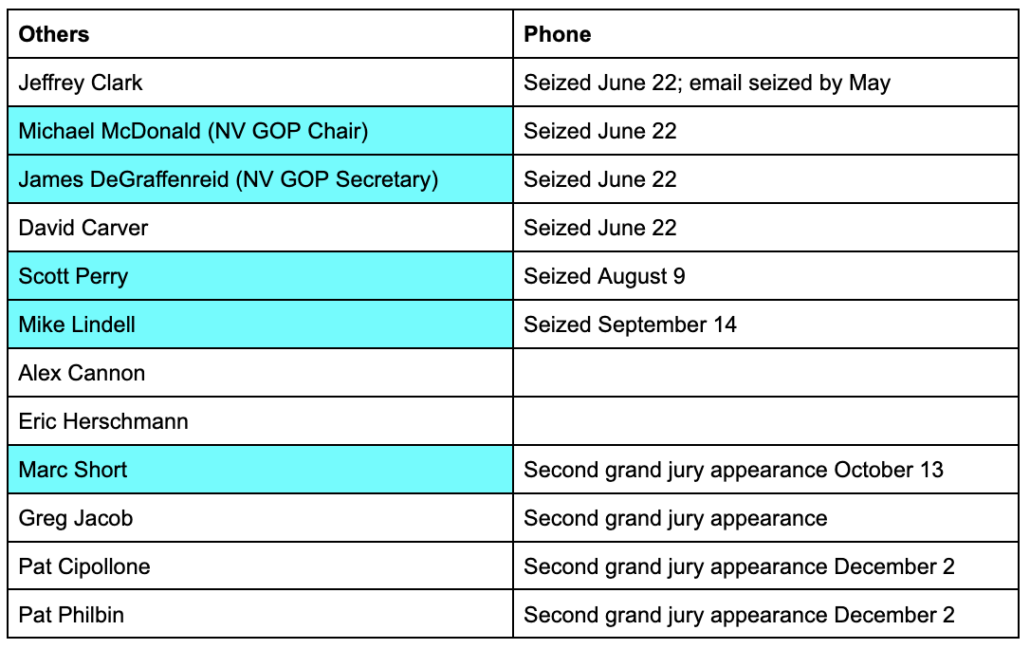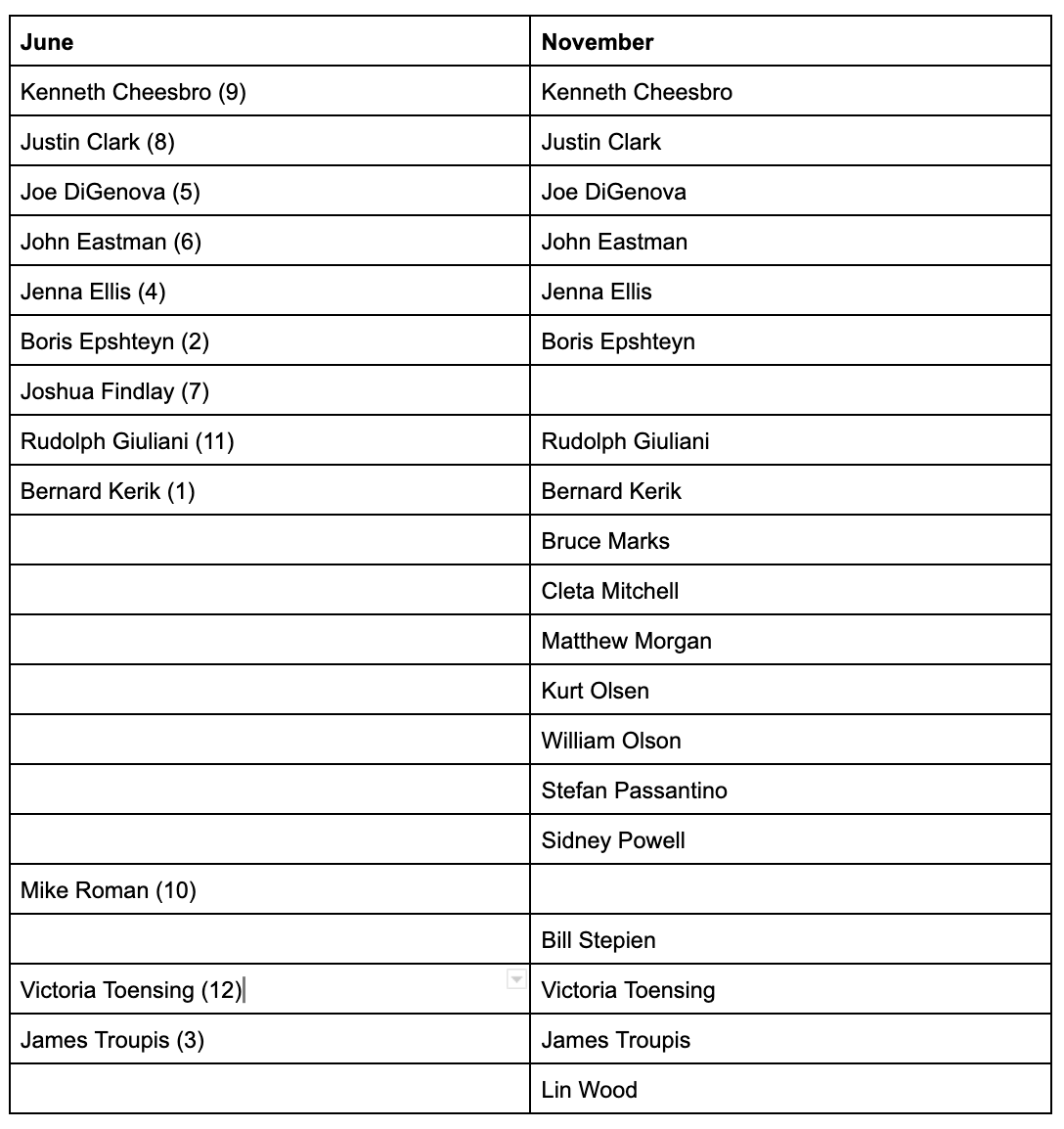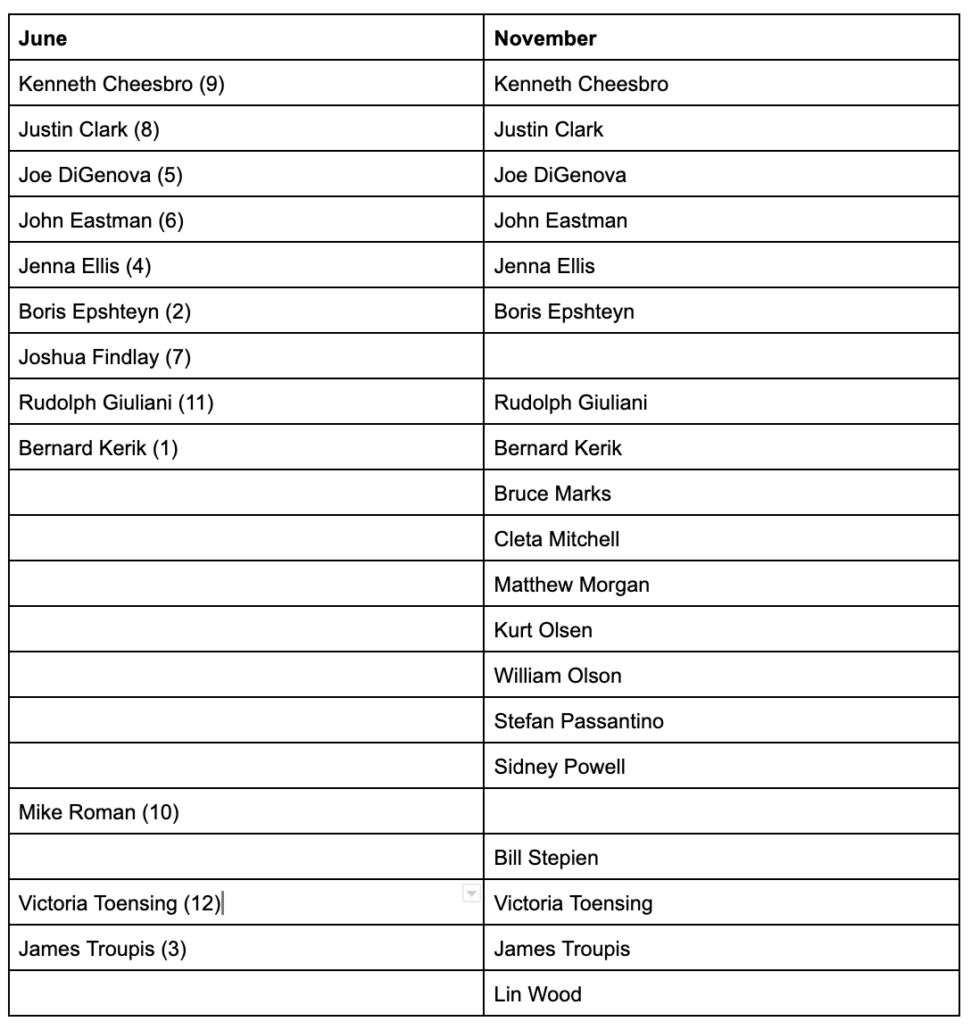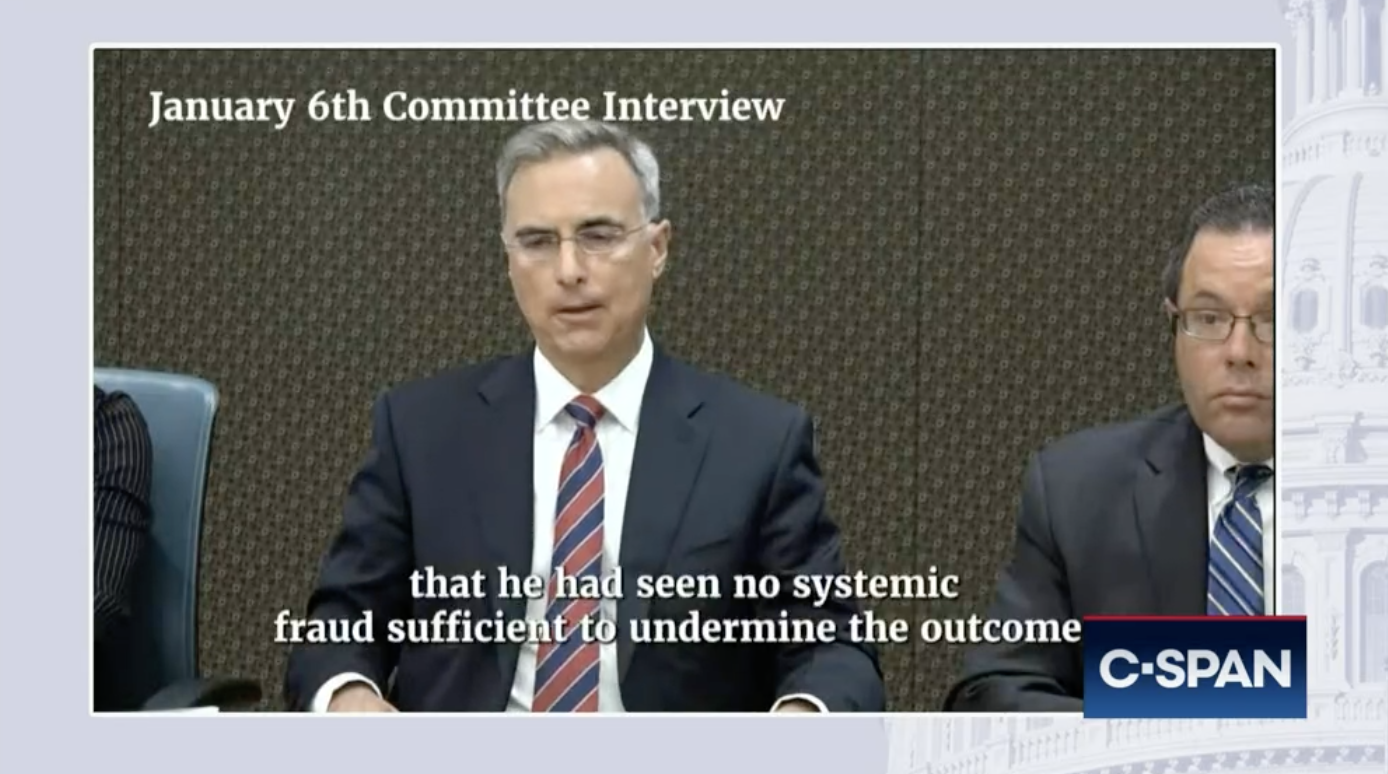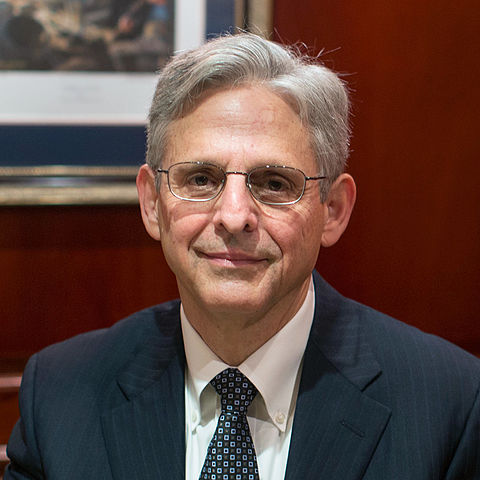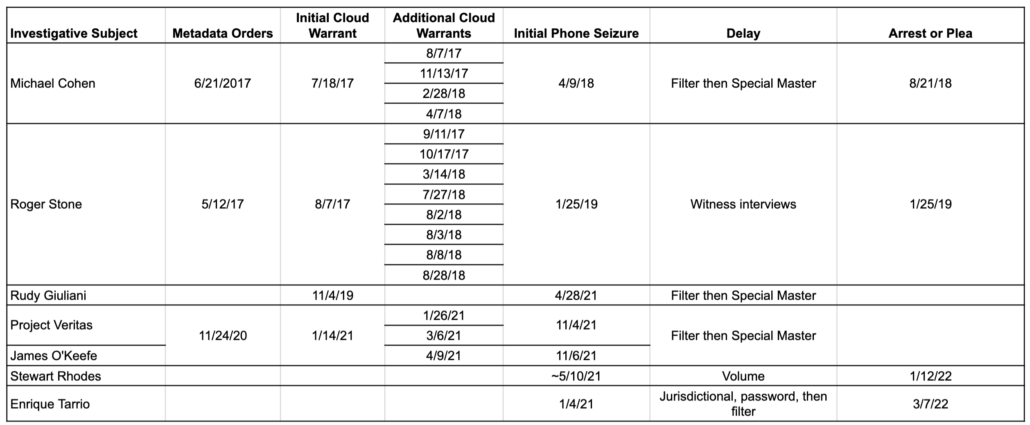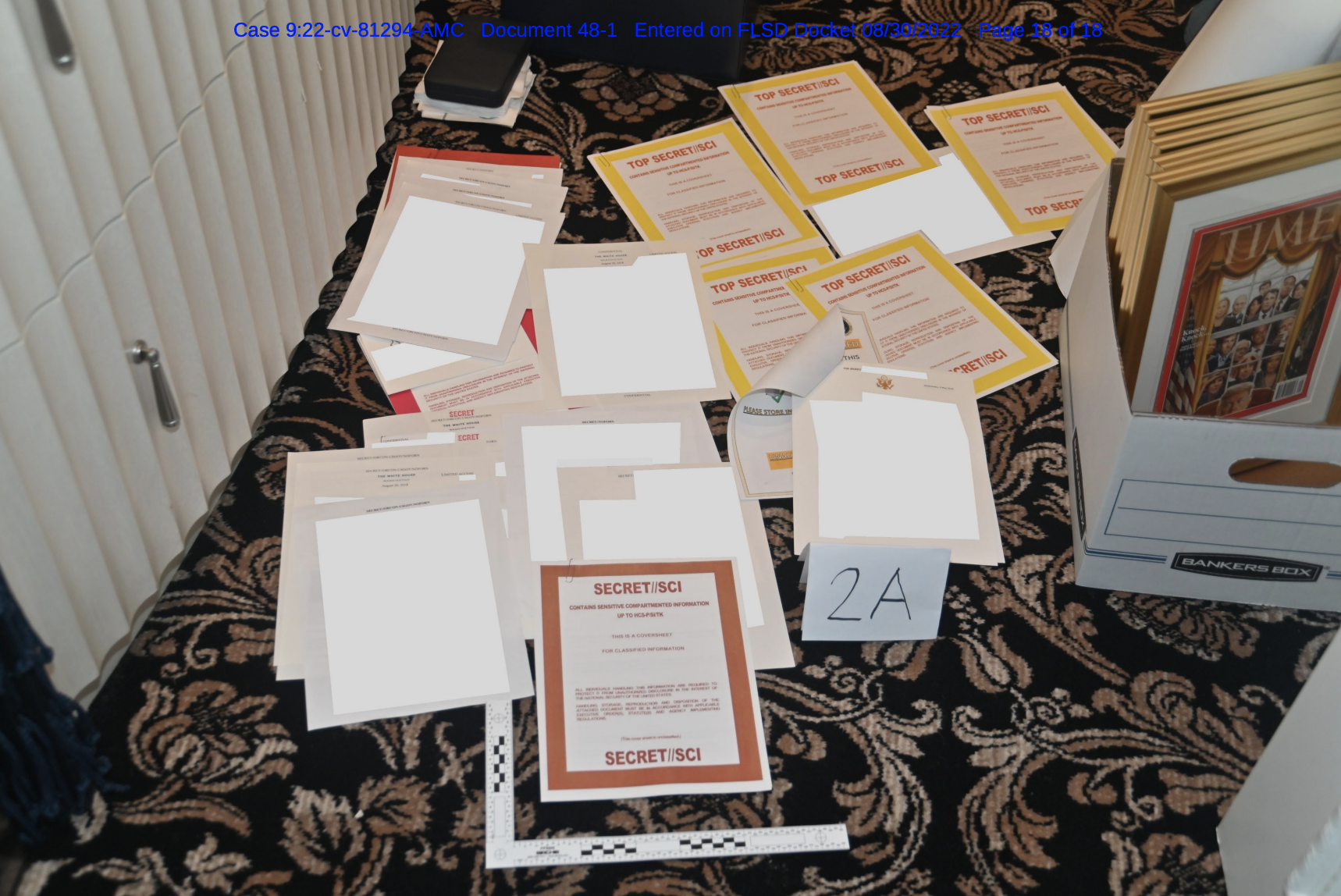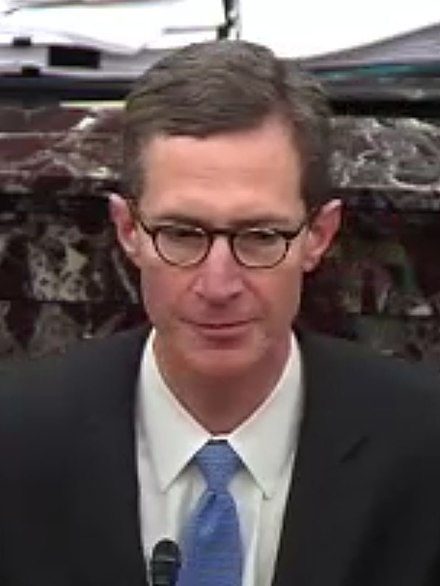Where the Trump Investigations Stand: The January 6 Conspiracies
As noted in this post, I started to write short summaries of where the three main investigations into Trump stand, but they turned into posts. So I’m posting them serially. I wrote about the Georgia investigation here and the stolen documents investigation here.
On Thursday, Mike Pence testified to the January 6 grand jury for over five hours. Many commentators have suggested — and I agree — that was one of the last major testimonial steps Jack Smith would need to take before deciding whether and if so how to charge Trump for inciting a mob to threaten to assassinate his Vice President.
But — in addition to Smith’s efforts to obtain recordings from Rudy Giuliani and others that former Fox producer Abby Grossberg has in her possession (which are going to make great evidence at trial) — there are still a few pieces that Smith’s prosecutors seem to be working on.
The most important of those may be continued appellate uncertainty regarding the law that Smith is likely to use to charge Trump and others in conjunction with January 6, obstruction of the vote certification, 18 USC 1512(c)(2), a charge successfully used against dozens of other January 6 defendants already. The DC Circuit will have a hearing on that, in an appeal former Virginia cop Thomas Robertson made of his obstruction conviction, on May 11.
To understand its import, let me explain how I think the various things Smith is investigating fit together. I think it likely that, in addition to some charges relating to the obstruction of this or the January 6 Committee’s investigation, Smith’s team is pursuing:
- Conspiracy to defraud the United States for submitting fake elector certificates to the Archives (18 USC 371)
- Obstruction of the vote certification and conspiracy to obstruct (18 USC 1512(c)(2) and (k))
- Conspiracy to commit wire fraud (18 USC 1343; 1349)
- Aiding and abetting assault (18 USC 111(b) and 2)
This differs from the January 6 Committee’s referrals in that I’ve included wire fraud, for which they provided abundant evidence, in an appendix, but did not include in their referrals. Also, I believe Smith would charge conspiracy tied to January 6 under 1512(k) rather than 371, as DOJ has been doing for over a year, not least because it provides stiffer sentences and more flexibility at sentencing. And I’ve suggested DOJ might use aiding and abetting of Michael Fanone’s assault based off Amit Mehta’s ruling addressing it and the evidence DOJ used in the Ed Badalian trial. I think that’s more likely than a charge for incitement of insurrection (18 USC 2383) unless DOJ built upwards off of still-hypothetical guilty verdicts in the Proud Boys case, but it might take time. I frankly think adding seditious conspiracy charges would be more likely than incitement of insurrection, if one spent the time to build up the intervening case, but that’s highly unlikely for constitutional reasons.
The way these three main charges — conspiracy to defraud tied to the fake elector certificates, conspiracy to obstruct the vote certification, and wire fraud — intersect likely provide some prosecutorial tools for the same reason that some Georgia Republicans are now turning on other ones.
While the fake electors case may seem like a slam dunk, the criminal exposure it presents is quite uneven.
Part of that stems from the fact that the extent to which a fake certificate was fraudulent is tied to state law about the requirements for elector ascertainment. On December 9, 2020, campaign lawyer Kenneth Cheesebro wrote down (!!) where such efforts would be less and more problematic.
Many of the States contested by the Trump team had laws that specified requirements for electors to validly cast and transmit their votes—and the December 9, 2020, memo recognized that some of these criteria would be difficult, if not impossible, for the fake electors to fulfill. (As described later, most were not fulfilled.) For example, Nevada State law required that the secretary of state preside when Presidential electors meet,16 and Nevada Secretary of State Barbara Cegavske, a Republican, had already signed a certificate ascertaining the Biden/Harris electors as the authorized, winning slate.17 Several States also had rules requiring electors to cast their votes in the State capitol building, or rules governing the process for approving substitutes if any original proposed electors from the November ballot were unavailable. As a result, Chesebro’s December 9, 2020, memo advised the Trump Campaign to abide by such rules, when possible, but also recognized that these slates could be “slightly problematic in Michigan,” “somewhat dicey in Georgia and Pennsylvania,” and “very problematic in Nevada.”18
That memo marks the moment when Trump’s official campaign lawyers like Justin Clark and Matt Morgan started to distance themselves from the campaign efforts, to be replaced by Rudy Giuliani and his band of merry warriors.
Something similar happened at the states, as smarter people insulated themselves from this stupid legal move. The fake electors in New Mexico and Pennsylvania included caveats that likely protects them from legal exposure; in other states (notably, Wisconsin) the fake electors credibly believed that the certificates would only be used if a court ruled that there was some remaining legal dispute. Fourteen fake electors refused to participate, several of whom had very useful things to say about its dubious legality even to the January 6 Committee.
While there’s lots of documentary record reflecting that Trump approved the plan, proving his knowledge of the legal problems with the fake certificates themselves would likely require witnesses who saw him do so after having been advised of the legal sketchiness of it all (that may have been among the things the two Pats, Philbin and Cipollone, were asked about in their grand jury testimony in December). To include Trump in these charges, you need witnesses. His call to Brad Raffensberger and his assent to a lawsuit using numbers known to be dodgy are related; his pressure on electors to participate is part of the same conspiracy; but to charge him with the conspiracy itself you need those direct witnesses (in addition to the two Pats, Jason Miller, Rudy, Mark Meadows, Epshteyn, and John Eastman are likely those witnesses).
By last June, the subpoenas DOJ sent out asking for communications with those deeply implicated reflected this differential exposure. So do the phone seizures of Mike Roman and Epshteyn in September, both of whom were key gatekeepers of this process. This post shows how the investigation proceeded from there. In other words, the parts of the fake elector investigation we can see reflect awareness from before the first J6C hearing that the scam implicated differential legal exposure.
That kind of differential exposure is the same thing that Fani Willis is using to secure cooperating witnesses in Georgia.
While I’ll come back to it, the same kind of differential exposure exists with the wire fraud case. Just as one example, while Justin Clark claims to have distanced himself from the obviously illegal fake elector scam, he remained in Trump’s employ as he spent the money earned from making false claims about voter fraud between November and January. He already would have had an incentive to provide evidence to prosecutors that he had no part of the fake electors scheme. His incentive to do so increases to the extent that he benefitted from fraudulent fundraising and spending.
But first I want to explain one thing Smith may be waiting on: A clear sense of how the DC Circuit will define “corrupt purpose” under 18 USC 1512(c)(2).
If he charges it, Smith will likely prove that Trump obstructed the vote certification by:
- Asking Mike Pence to take action to delay the certification that Trump had been told was illegal (Greg Jacob, Mark Short, the two Pats, and Pence are witnesses to this, all of whom have now made Executive Privilege-waived grand jury appearances)
- Falsely leading the mob to believe that Pence could take that action (changes Trump made to his speech, about which Stephen Miller was likely asked by the grand jury this month, and his tweets are evidence of this)
- After Pence refused to take that action, using the mob to try to pressure him to take it anyway or to otherwise disrupt the certification (DOJ has spent two years obtaining evidence that this was, in fact, why many people rioted, with specific evidence tied to Danny Rodriguez)
Contrary to what a million TV lawyers have told you, to prove obstruction, Smith won’t have to prove Trump knew he lost. DOJ has repeatedly won convictions of other January 6 defendants who tried to use that as a defense.
DOJ will need to prove he had corrupt purpose in attempting to obstruct the vote certification. And what that means in the DC Circuit won’t be decided until after May 11.
This post provides both a summary of the debate as it existed in January. This post describes how a DC Circuit panel of Florence Pan, Justin Walker, and Greg Katsas ruled that 1512(c)(2) does apply to the vote certification and that obstruction can extend beyond documentary obstruction. It also explains how none of the three of them could agree on what “corrupt purpose” means, from which some January 6 defendants have tried to argue (unsuccessfully in at least two cases) that Walker’s preferred meaning should apply.
Wildly simplified, the three main definitions of what corrupt purpose might mean are:
- Corrupt benefit
- Using otherwise illegal means, which in the case of other January 6 defendants has meant trespass or assault
- Aiming to obtain an unlawful benefit
On May 11, a DC Circuit panel including Pan, Poppy Bush appointee Karen Henderson, and Obama appointee Cornelia Pillard will consider whether former Virginia cop Thomas Robertson had the corrupt purpose required to be convicted of obstruction. As part of that, they’ll decide whether the earlier ruling decided the issue of what corrupt purpose is, and if not, what it is.
As I wrote, to the extent that Smith has proof Trump knew the fake elector certificates were fraudulent, 1512 should apply to Trump in every imaginable case, far more easily than it does with rioters. The attempted delivery of the fake elector certificates to Pence constitutes a documentary attempt to obstruct the vote certification. Trump’s illegal request to Pence, as well as the knowingly fraudulent lawsuit in Georgia and the effort to pressure Raffensperger, to say nothing of any incitement or aid-and-abet liability in the assaults, are illegal means he used to stop the vote certification. And Trump, more than anyone else involved in efforts to obstruct the vote certification on January 6 was seeking an unlawful personal benefit, the ability to remain in power for another term. Mitch McConnell protégé Walker clearly laid out that basis for that case in his concurring opinion in Fischer.
But former Trump White House counsel Katsas didn’t necessarily view the continued election of Donald Trump to be such an advantage, at least not for those accused of assault before him. He sought a stricter definition of “financial, exculpatory, or professional” gain.
Which brings me (back) to the wire fraud investigation, something that DOJ has been investigating since at least September and in which CNN reported DOJ got cooperators after January 6.
[T]he financial investigation has sought information about Trump’s post-election Save America PAC and other funding of people who assisted Trump, according to subpoenas viewed by CNN. The financial investigation picked up steam as DOJ investigators enlisted cooperators months after the 2021 riot, one of the sources said.
Wire fraud charges would closely resemble the successful Build the Wall prosecution for which Steve Bannon’s co-conspirators just got four year sentences (he was pardoned in for it in one of Trump’s last pardons but faces trial for the same scam in New York State in November). It would follow a similar wire fraud investigation of Sidney Powell that dates back to before September 2021.
If you think of these three prongs of the investigation, the wire fraud prong serves two purposes. First, many of the people who were witnesses but not subjects of the events leading up to January 6 might be subjects of the wire fraud investigation. As I noted, it may provide a tool to get cooperators.
Just as importantly, even under the most constrained definition of corrupt purpose for obstruction, grifting off false claims of election fraud would qualify.
That is, for Trump, a prosecutor should be able to prove corrupt purpose regardless of any conceivable standard that the DC Circuit or even a conservative SCOTUS would adopt, because he attempted to obstruct the vote certification so that he could remain President after losing the election.
But even if you don’t believe getting Trump elected provides an unlawful benefit to his supporters (or, to put it another way, disqualifying the votes of 81 million other Americans so yours counts more), disseminating false claims about voter fraud to get rich and then cashing in on that Big Lie for years afterwards is a different kind of corrupt purpose, the kind of financial corrupt purpose that Katsas is looking for.
If you riled up tens of thousands of Trump supporters who went on to attack the Capitol just so you could benefit financially, you’ve realized the kind of corrupt financial benefit from the riot that would seem to meet Katsas’ most constrained definition of corrupt purpose.
So it’s not just that the wire fraud part of the investigation is a crime that should, like all the other ways Trump and his flunkies have exploited his credulous followers, be prosecuted. It’s a important complement to the two other conspiracies, both because it’s likely to motivate more cooperators, but also because it helps to prove corrupt purpose for all the people who profited off the fraud.
And that may have an impact on the timing.
As I’ve noted, Trump should qualify under the definition of corrupt purpose no matter what the DC Circuit decides, though some of his flunkies might not. And so on top of whatever continued investigation Smith has to do on the wire fraud prong, he may want to wait until at least after that hearing before he makes final charging decisions.
Lots of people are impatient that neither Trump nor his flunkies have been charged thirty months after their crimes. But the likely charge hasn’t even been defined yet.
Links
Where the Trump Investigations Stand: Georgia
Where the Trump Investigations Stand: Stolen Documents
Where the Trump Investigations Stand: The January 6 Conspiracies


